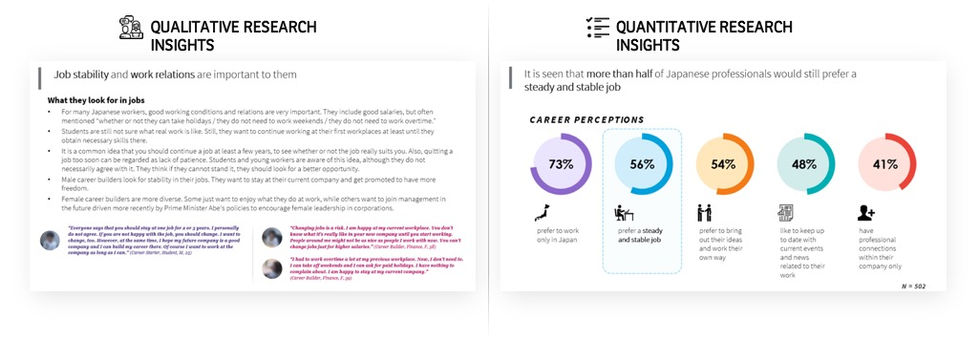
Uncovering Japanese Professional Networking Culture
Digital professional networking - User Perception Research
What is the project about?
The product is mainly used for professional networking, including employers posting jobs and job seekers posting their CVs. It allows members to create profiles and connections to each other in an online social network which may represent real-world professional relationships.
Business challenge
Client had been working on its consumer product strategy for the Japanese market. They understand that Japan is a unique market, so they need to re-think how their products are seen by Japanese professionals. They want to dive deeper into the market through an ethnographic study to build their Japan strategy.
Goal of the project
Client's core Value Propositions are:
Getting a job
Learning a skill (Online Learning)
Content (News)
Professional Networking
Planned learning objectives of the research are:
Are these value propositions tangible needs for Japanese professionals?
How strongly do these value proposition resonates with users (strength of the need)
Who are the dominant players in the Japanese markets which address these needs? (Competitor Analysis)
Tools
Survey programming & hosting
SPSS
WebEx
BlueJeans
Team
Senior Research Analyst (me)
UX Researchers (client)
Senior Manager - Research & Analytics
Project Manager
My Role
Research scope & methodology
Sampling plan
Questionnaire designing
Data Analysis
Reporting Insights & Recommendations
Editing qualitative interview videos
Timeline
Overall: 8+ weeks
Discovery & Planning: 1 week
Qualitative Research: 4 weeks
Quantitative Research: 1 week
Data Analysis & Presentation: 2 weeks
User Research Process
Research Scope & Methodology
To understand the perception and needs of Japanese professionals with respect to professional networking, job search and learning new skills, along with the pain points associated with the same
Determine the decision-making process to undermine the key differentiating factors and current need gaps
Image assessment of Client Product vis-à-vis key competition like Line Messenger or Facebook when it comes to Professional Networking
Defining the Sampling Plan
To gain a comprehensive understanding of user needs and preferences, we conducted both qualitative and quantitative research across various user segments. This involved in-depth interviews, focus groups, and usability testing to gather rich qualitative data, as well as surveys and analytics to collect quantitative insights.

"Changing jobs is a risk. I am happy at my current workplace You don't know what it's really like in your new company until you start working. People around me might not be as nice as people I work with now. You can't change jobs just for higher salaries."
"I think people around me would know what I am like if I work hard."
"It is not very polite if you just send an e-mail message without calling. In my mind, e-mail is not the proper first contact method."
Designing Discussion Guide for FGDs and IDIs
A discussion guide was a set of questions/topics that the researcher referred to walk the participant(s) through in order to reach the learning objectives.
Key learning objectives through Qualitative research:
Understand how Japanese professionals do the following and understanding their pain points:
find a job (both first job and subsequent jobs)
read business content and industry news (e.g., newspaper...)
whether, how and how often they build skills (e.g., online learning, classes)
Understand who is in their professional network and how it overlaps with their personal. How many are coworkers vs. people in other parts of the company or other companies
Is public professional profile a viable concept?
How do they engage their professional network? Pain points? Facebook, Line, others?
Is Facebook truly a threat/substitute for professional network?
Conducting the Qualitative research
We conducted 3 in-person Focused Group Discussions (FGDs) with:
Career Starters (4 participants)
Male Career Builders (4 participants)
Female Career Builders (4 participants)
Post that, 3 In-Depth Interviews (IDIs) with one participant from each group (3 participants)
The sessions were conducted a facility in Tokyo, which was equipped with all necessary equipment, a facilitator and a simultaneous interpreter
Moving to Quantitative research
The survey questionnaire was drafted to collect, analyze and interpret the different views of the target user group across. The quantitative survey was conducted to validate the learnings from the qualitative research with an extended population set.
The questionnaire consisted of the following sections/topics:
Screener & Demographics
Technological exposure
Workforce trends/Professional behavior
Professional Relationship & Networking
Brand Perceptions into Career & Professional aid
Deep dive into brand features & suggestions

Japanese professionals prefer face to face meets with work colleagues. Exchanging business cards are more preferred with clients.
"I use Eight (app) to organize my name cards. It is quite useful."
"Collaboration features are difficult to use for non-English terms, business card feature is missing."
Analysis, Reporting and User Insights
By synthesizing qualitative and quantitative findings, several consistent patterns and valuable insights came to light:
Only 28% among the total respondents were aware of the platform
Job stability and work relations are important to Japanese professionals
Facebook & LINE Messenger are the top social networking platforms for informal communication. They prefer exchanging business cards and face to face meets with their clients
Newspapers and Magazines are prefereed sources of information for professional development. They also participate in on-job trainings to become more productive at work
Fun fact: 2 in 3 Japanese professionals only have 0-2 valid certifications
Becoming more productive at work was the top value proposition and reason for professional development

















